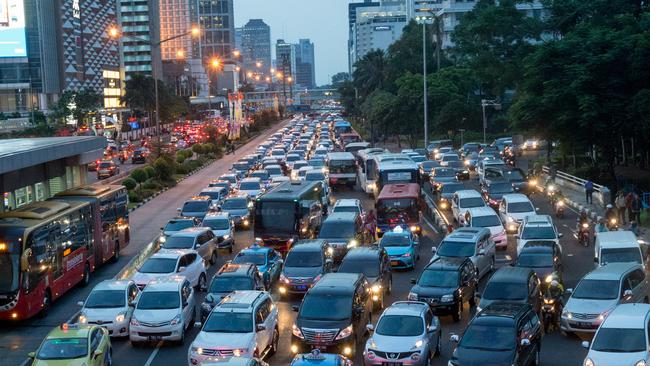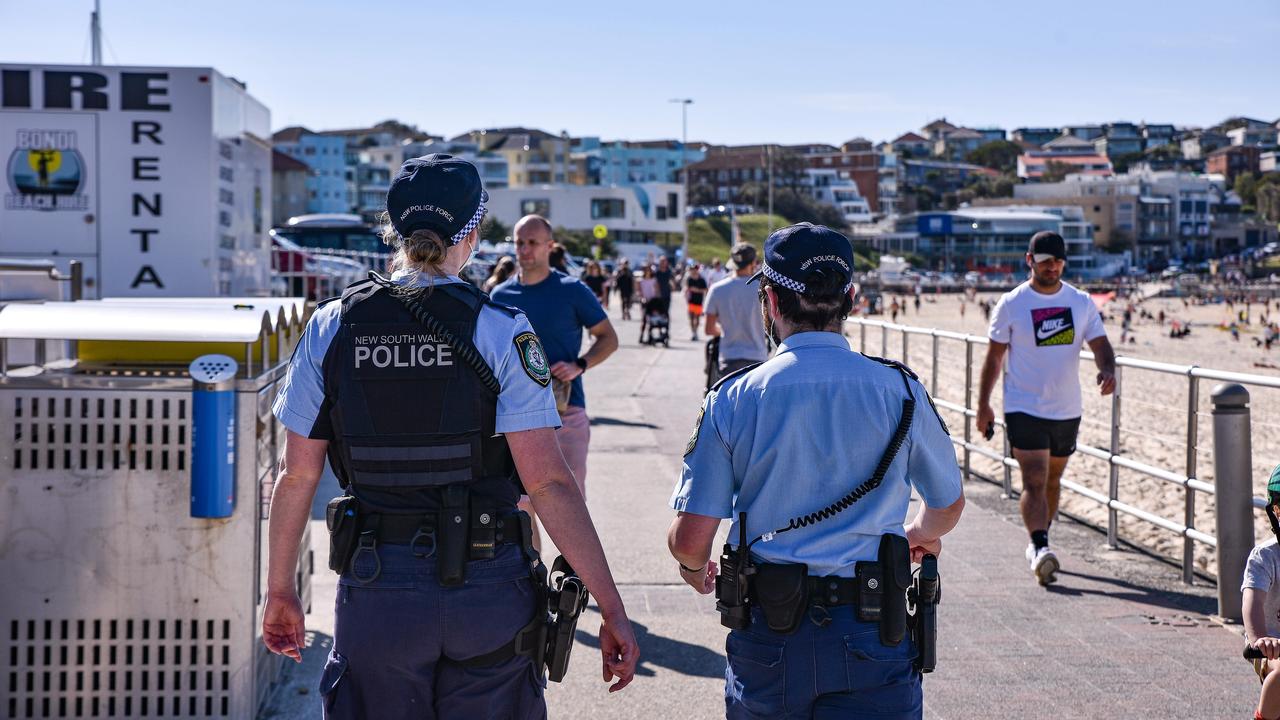Indonesia mulls moving capital to escape gridlock
Jakarta is sinking in sediment after decades of bad planning.

Every weekday, Henny Warsilah and her husband wake in the early dark for a three-hour traffic apocalypse — their commute from Bogor to Jakarta.
In three decades, the sociologist’s 50km journey has tripled in duration, even as the road has expanded to accommodate an explosion in private vehicles.
“I grow old on the road,” bemoans Warsilah, 57.
The same can be said of 13 million people who live in Indonesia’s capital or commute there in some of the world’s worst traffic.
In July, 12 people died in a three-day traffic jam 350km west of Jakarta as millions of people travelled for the Islamic holiday of Eid ul Fitr. Among them was a one-year-old baby said to have died from vehicle fumes.
A study by Castrol found drivers in Jakarta stop and start their cars on the road more than in any other city in the world — an average 33,240 times a year (Brisbane has 6960).
Jakarta is the world’s second-largest urban area and has one of its fastest-growing economies, but the only way to expand is to go up or under — and under is restricted by sinking sediment.
After decades of inaction, the Indonesian and Jakarta governments have launched overlapping projects: a metro system, light rail, 900 new buses this year, an electronic road toll pricing system, an airport link, flyovers, six road corridors and limits on motorcycles.
Yet even the most optimistic estimates suggest those projects will reduce Jakarta’s traffic by just 30 per cent. The city’s governor admits it could take up to 40 years to fully overcome the congestion.
“We are facing potential gridlock by 2020 if the government doesn’t make significant improvements to the whole policy, not just reducing traffic.” says Dono Boestami, who is in charge of building a rapid mass-transit metro system for Greater Jakarta.
Many Jakartans believe traffic worsened in July after the scrapping of the three-in-one traffic system along arterial roads. It did so to wipe out the “jockeys” — hundreds of unemployed Jakartans who lined the roads offering their services as paid passengers.
The decision was made after a female jockey was found to be renting a six-month-old baby, and drugging him to boost her potential market among solo drivers needing two passengers to legally use the road in peak hours.
Last month, the government introduced a system restricting access along main roads on alternate days to cars with numberplates ending in odd or even numbers.
Warsilah says a bolder solution is required. “There’s no more land in Jakarta, which is why the idea of shifting the administrative capital to another city is such a good one,” she says.
“You won’t improve Jakarta unless you … improve the infrastructure and move the capital.”
The Indonesian Institute of Sciences professor is part of a movement pushing for structural change in Jakarta.
The plan to shift Indonesia’s financial and administrative centre outside Jakarta has been raised and shelved numerous times for decades, but the idea is back on the table and has supporters. Shifting the country’s ministries, parliament and all 140 state-owned enterprises could be the simplest solution, Boestami says. He points to Putrajaya, the planned city outside Kuala Lumpur that became Malaysia’s administrative and financial capital in 1999 to relieve congestion.
“The biggest state-owned companies, like Pertamina and PLN, have tens of thousands of employees. If they were to move their headquarters also,” it would significantly reduce traffic, he says.
Jakarta began life in the 1600s as a fishing village, chosen — ironically given today’s water crisis — for its proximity to fresh water. Dutch colonists fancied the port city might one day accommodate 500,000 people.
More than 10 million are now jammed into 700 sq km during the night, blowing out to 13 million during the day. They fight for space on a road network less than half the size it should be. Greater Sydney is on 12,367 sq km with a population of 4.6 million.
“For any major city of the world to function, it has to have a minimum 16 per cent (of its total area) for roads,” says Scott Younger, a Jakarta-based infrastructure specialist and academic.
Jakarta has 7.3 per cent. The road system has grown at 0.01 per cent a year, even as giant office towers and apartments sprouted like weeds and the motorbike army expanded by 36 per cent every year. Public transport has expanded at just 1.2 per cent a year for the past 35 years.
Jakarta is a cautionary tale of a city sinking, figuratively and literally, under the weight of a million bad decisions.
“You need space for a city of this size and the planning should have started in the 1970s. Jakarta has always played catch-up and now we’re in a bit of a mess,” Younger says.
“In 1970, the city was five million people. That’s when we needed to actually start looking at what was the future.
“I can understand why the opportunity was missed but we’re facing the penalty now. There are 30 million people or more in Greater Jakarta (including satellite cities Bogor, Bekasi, Depok and Tangerang) and it’s due to be 50 million in the next 35 years.
“It took me more than 1.5 hours to get 1.5km along Sudirman (one of the city’s major roads). There’s a complete lack of capacity.”
Jakartans have a love-hate relationship with their vehicles but that doesn’t stop them adding 1000 more to the roads every day.
As more Jakartans move into the middle class, “the first thing they do is buy a motorbike or a car”, Boestami says. “That is going to become a big, big problem.”
The gridlock has become a powerful disincentive for investors. Losses in time, income and efficiency to traffic jams in Jakarta are estimated to cost up to 65 trillion rupiah ($6.48 billion) a year.
The MRT project, costing $1.5bn across five years for the first 27km, is a bargain, Boestami says. The first phase — a south to north corridor with 13 stations and a train arrival every five minutes — is to be running by early 2019.
But there are more important issues than just time and money lost to the macet (traffic jam).
The average response time of Jakarta’s Emergency Ambulance Service is about 37 minutes, although when the city sleeps it can fall to 15 minutes.
“It’s a very, very long response time and we are trying to solve that problem,” EAM director Erizon Safari admits.
“But not everyone is getting better at giving way.”
EAM spokesman Anhari says demand for the service has doubled in recent years. It now responds to 2400 calls a month but struggles to reach patients in the so-called golden period, the first 15 to 20 minutes before heavy blood loss or breathing difficulty can cause irreversible damage.
“That’s one of the main challenges,” Anhari says. “It’s 50-50 we can get there on time.”
The service plans to introduce motorcycle paramedics as first responders.
When Boestami sought inspiration for how to deliver a rapid-transit rail system to Greater Jakarta — the world’s second-largest urban area, after Tokyo — he looked to New Delhi.
From early 2010, New Delhi residents flocked underground to efficient public transport that bears little resemblance to the grimy bedlam above.
At its deepest point, Jakarta’s metro tunnel is 33m underground, below the city’s soft sediments which are steadily sinking thanks to groundwater extraction.
Fr Boestami, building a safe and reliable public transport system for a city sinking faster than Venice is less challenging than convincing the capital’s residents to get on board.
Jakartans don’t walk — not to work, not to school, sometimes not even the 400m from the office block to the shops. If they can hitch a ride, usually on a motorcycle taxi, they will do so.
“The challenge for Jakartans in general is to change their mindset on how to travel,” Boestami says. “My personal goal before leaving this job is to force Jakartans to walk 350m to the (metro) station.
Achieving that will require a transformation of the city’s unsafe pedestrian infrastructure, including widening footpaths.
One Jakarta office worker says her “biggest fear is falling into the sewer” through the broken footpath that rocks underfoot. She recounts a motorcyclist riding on the footpath who “nudged me from behind because I refused to let him pass”.
Warsilah insists Jakartans used to love to walk — back when the city had parks, big trees, fewer cars and less pollution. “Until the early 1990s it was still very, very pleasant, but after that we started to see a lot of these superblocks — tall buildings, hotels, apartments — which basically eliminated all the green space available.”
Planning law requires 30 per cent of land be put aside for open space, yet there is only 7 per cent — and that is after recent demolitions of illegal slums.
The numbers are clearly against it. But Jakarta’s survival — and that of many similarly overcrowded megacities — depends on an administration determined to reverse its sinking fortunes.



